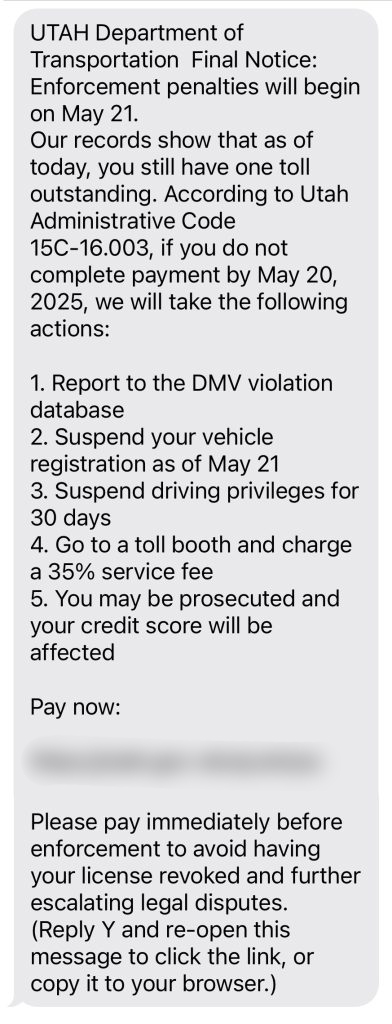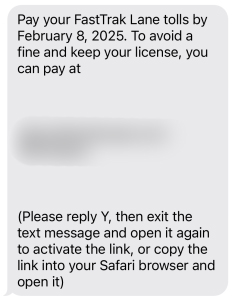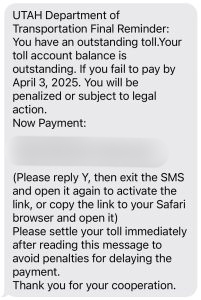Spot the Scam
The Utah Division of Consumer Protection (Division) is alerting Utahns to a widespread phishing text scam. Scammers are impersonating legitimate toll authorities, including the Utah Department of Transportation (UDOT), by sending fraudulent text messages. These texts falsely claim you have an unpaid toll balance and threaten legal action if immediate payment isn’t made.
This scam aims to create urgency, pressuring recipients to click on malicious links and divulge personal and financial information. Be aware that these deceptive texts often use official-sounding language and may even include “utah.gov” within an otherwise suspicious link to appear legitimate.
UDOT has confirmed they do not send texts or make phone calls to collect tolling fees. Any message claiming to be from UDOT for toll collection is a scam. If you are genuinely concerned about an unpaid toll, always contact the relevant authority directly. Use a verified phone number from their official website (e.g., expresspass.utah.gov for UDOT Express Pass inquiries), not any number provided in a suspicious text message.
How to Spot a Phishing Text Scam

Knowing the common characteristics of phishing attempts can help you avoid becoming a victim:
- Sense of Urgency: Scammers thrive on panic. Messages demanding immediate action or threatening penalties are significant red flags.
- Suspicious Links: Before clicking any link, hover over it on a computer or long-press on a phone to reveal the true URL. If the revealed URL looks strange, even if it contains familiar words, do not click it.
- Generic Greetings: Legitimate organizations typically address you by name. Generic greetings such as “Dear Customer” can indicate a mass scam attempt.
- Grammar and Spelling Errors: While not always present, errors in grammar and spelling can be a telltale sign of a scam.
- Requests for Sensitive Information: Legitimate entities will never ask for your Social Security number, banking details, or passwords via text message.
What to Do If You Receive a Phishing Text

If you receive a suspicious text message:
- DO NOT click on any links.
- DO NOT respond to the text message, even to reply “STOP”. Responding confirms your number is active and can lead to more scam attempts.
- Block the sender’s number.
- Delete the message.
If you have mistakenly clicked a link or provided information, immediately contact your bank or credit card company to report potential fraudulent activity.
Where to Find Help and Learn More About Scams

The Utah Division of Consumer Protection is dedicated to helping protect you from scams.
- Forward the Text Message: Forward suspicious texts to 7726 (SPAM). This helps your mobile carrier identify and block scam numbers.
- Report to the FTC: File a report with the Federal Trade Commission at ReportFraud.ftc.gov.
- Internet Crime Complaint Center (IC3): For online scams, report to the FBI’s IC3 at ic3.gov.
- Learn More: scams.utah.gov offers valuable resources and information on various scams, including which Division within the Utah Department of Commerce may be able to help.
Stay vigilant, trust your instincts, and remember: if it seems too urgent or too good to be true, it’s likely a scam. Your awareness is your best defense against these fraudulent schemes!










